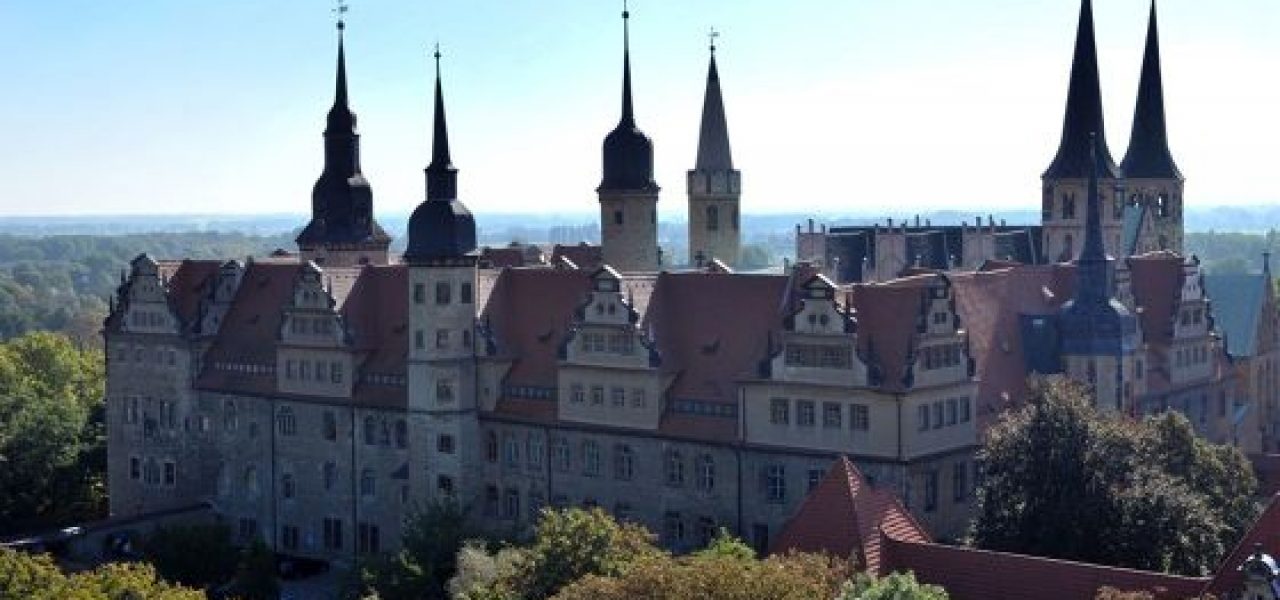INTRODUCTION
The Cathedral of St. John and St. Lawrence is one of the most important cathedral buildings in Germany and was the favourite place of the only canonized imperial couple, Heinrich II and his wife Kunigunde.
HISTORY
Todays Cathedral of St. John and St. Lawrence goes back to the Johanniskirche donated by Heinrich I, which was also used as the church of the first diocese in Merseburg. The foundation stone for the construction of a representative cathedral of the diocese of Merseburg was laid on May 18, 1015, by Bishop Thietmar von Merseburg (Thietmar von Walbeck).
The first consecration of the four-tower church building of patron St. Laurentius took place in October 1021 in the presence of the imperial couple Heinrich II and Kunigunde. After two collapse gaps and therefore reconstructions, a second consecration took place in 1042. In addition to the crypt, only parts of the original Romanesque building have survived like the round choir escort towers from the middle of the 11th century, the basements of the west towers and the lower wall parts of the transept with the two eastern apses. The construction of a fifth tower above the crossing was initiated by the Merseburg Bishop Werner von Wolkenburg, which however collapsed unfortunately in 1230.
Later renovations, especially between 1510 and 1517 under Bishop Thilo von Trotha, transformed the cathedral in the late Gothic. For this purpose, the dilapidated nave was extensively renewed and received its current appearance with its high tracery gables.
In 1545 Martin Luther preached in the cathedral. After the death of the last Catholic bishop Michael Helding in 1561, the Reformation finally prevailed in Merseburg. Parts of the curia in the “Domfreiheit”, that have been preserved to this day, were rebuilt in the Baroque style after the Thirty Years’ War. Associated with this was the new construction of the cathedral grammar school building that still exists today.
During the airstrikes of World War II, the city of Merseburg was hit hard and the north and east wings of the castle, the chapter house and the choir of the cathedral were damaged. On 17th August 2006, the renovated chapter house was inaugurated in a ceremony in the presence of the Minister of Culture Jan-Hendrik Olbertz and Bishop Axel Noack.
ARCHITECTURE AND FURNITURE
Apart from the historical changes during the Reformation and the war-related destruction, the Cathedral is comparatively richly equipped, for its age.
Remains of medieval glazing have been preserved in four medallions with a diameter of approx. 60 cm above the west portal in the lobby in the centre of the three-window group. They depict the Annunciation, the Nativity, the Adoration of the Kings and the Crucifixion.
You can find a monolithic baptismal font made of red sandstone in the vestibule of the cathedral since 1831. The stone originally comes from the Neumarktkirche in Merseburg, which was first mentioned in 1188 and cannot be much older. The baptismal font also dates from this period.
The so-called royal crypt is an important monument of baroque burial culture. The crypt was originally divided into three rooms, which were furnished between the 13th and 16th centuries. A magnificent portal shows the entrance to the prince’s crypt, the painting above the portal shows the ducal family.
Several altars have been preserved in the Cathedral. First of all, there is a supporting altar of Lower Saxony or Central German origin dating from the first third of the 13th century. It consists of a rectangular wooden body made of oak with a hexagonal recess on the top to hold a relic.
In the church and the cloister are epitaphs and tombs of bishops, canons and nobles, many of whom are artistically outstanding.
The most important work of art is the tomb slab in the choir of Rudolf von Schwaben, who died on October 15, 1080. It is considered the oldest portrait tomb of the German Middle Ages. The technical perfection of bronze casting is particularly noteworthy and outstanding.
The cathedral houses behind a baroque prospectus from around 1700 one of the largest romantic organs in Germany, created using registers from the previous organ in two stages in 1855 and 1866 by the organ builder Friedrich Ladegast. From 2003 to 2006 it was extensively restored by the organ building companies Eule, Scheffler and Wegscheider.
OPENING HOURS
March – October:
Monday – Saturday 9.00 – 18.00
Sundays and religious holidays 11.00 – 18.00
November – February
Monday – Saturday 10.00 – 16.00
Sunday and religious holidays 12.00 – 16.00
Special opening times
24.12. 9.00 – 12.00
31.12. 9.00 – 14.00
CONTACT
Merseburger Dom, Domschatz und Kinder-Domus Merseburch
Domplatz 7
06217 Merseburg
Phone: 03445 2301-0
E-Mail: www.merseburger-dom.de & verwaltung@vereinigtedomstifter.de
ENTRANCE FEES & GUIDED TOURS
Adults 7,50 Euro / reduced 5,50 Euro
Pupils 3,00 Euro
Family (2 adults including pupils) 19,00 Euro
Public guided tour with audioguide within opening hours (60 min):
Adults 3,00 Euro
For Groups, school classes and advanced bookings please check and request:
www.merseburger-dom.de/besucher-service/preise.html
ROUTE SUGGESTIONS
TOURIST INFORMATION OFFICE
Burgstraße 5
06217 Merseburg
Phone:03461- 21 41 70
Mail:info@merseburg-tourist.de
Website: www.merseburg.de/”>www.merseburg.de


